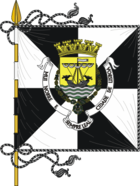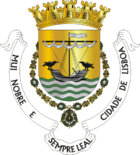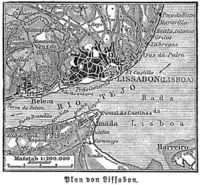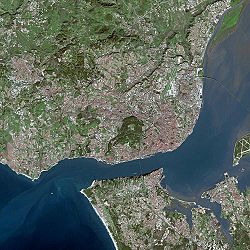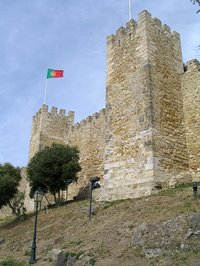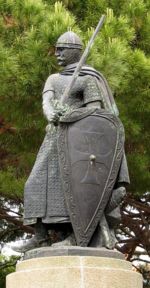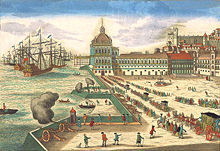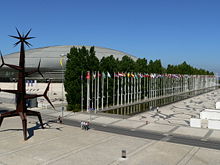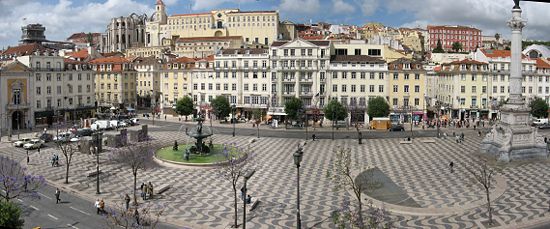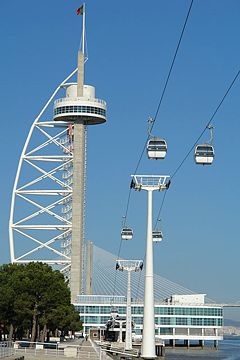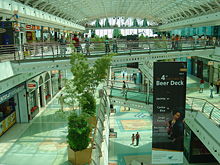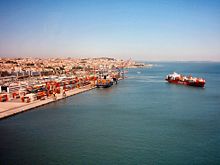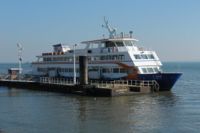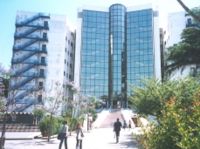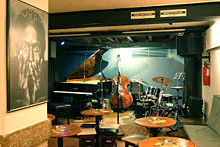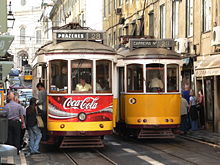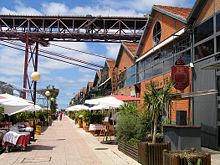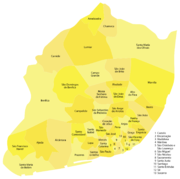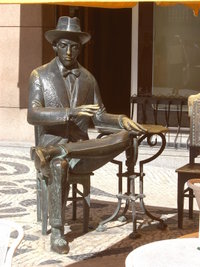Lisbon
2008/9 Schools Wikipedia Selection. Related subjects: Europe; European Cities
|
||||||
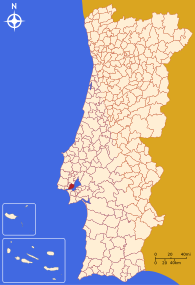 |
||||||
| Location | ||||||
| - Country | ||||||
| - Region | Lisboa | |||||
| - Subregion | Grande Lisboa | |||||
| - District or A.R. | Lisbon | |||||
| Mayor (list) | António Costa (elected) | |||||
| - Party | PS | |||||
| Area | 84.8 km² | |||||
| Population | ||||||
| - Total | 564,477 (2 million – contiguous urban area) |
|||||
| - Density | 6,368/km² | |||||
| No. of parishes | 53 | |||||
| Coordinates | 38°42'N 9°11'W | |||||
| Municipal holiday | Saint Anthony June 13 |
|||||
| Website: http://www.cm-lisboa.pt | ||||||
Lisbon (Portuguese: Lisboa, IPA: [liʒ'boɐ]) is the capital and largest city of Portugal. It is also the seat of the district of Lisbon and capital of the Lisbon region. Its municipality, which matches the city proper excluding the larger continuous conurbation, has a municipal population of 564,477 in 84.8 km² (33 sq mi), while the Lisbon Metropolitan Area in total has around 2.8 million inhabitants, and 3.34 million people live in the broader agglomeration of Lisbon Metropolitan Region (includes cities ranging from Leiria to Setúbal). Due to its economic output, standard of living, and market size, the Grande Lisboa (Greater Lisbon) subregion is considered the second most important financial and economic centre of the Iberian Peninsula. The Lisbon region is the wealthiest region in Portugal and it is well above the European Union's GDP per capita average - it produces 45% of the Portuguese GDP. It is also the political centre of the country, as seat of government and residence of the Head of State.
Lisbon was under Roman rule from 205 BC; Julius Caesar made it a municipium called Felicitas Julia, adding to the name Olissipo. Ruled by a series of Germanic tribes from the 5th century, it was captured by Moors in the 8th century. In 1147, the Crusaders under Afonso Henriques reconquered the city for the Christians and since then it has been a major political, economic and cultural centre of Portugal. Unlike most capital cities, Lisbon's status as the capital of Portugal has never been granted or confirmed officially—by statute or in written form. Its position as the capital has formed through constitutional convention, making its position as de facto capital a part of the Constitution of Portugal.
Lisbon hosts two agencies of the European Union, namely, the European Monitoring Centre for Drugs and Drug Addiction (EMCDDA) and the European Maritime Safety Agency (EMSA). The Community of Portuguese Language Countries (CPLP), is also headquartered in Lisbon.
The present mayor of Lisbon is António Costa, elected by the Socialist Party.
The municipal holiday is June 13, St. Anthony's Day.
Geography and location
Location
Lisbon is situated at 38°42' north, 9°5' west, making it the westernmost capital in mainland Europe. It is located in the west of the country, on the Atlantic Ocean coast at the point where the river Tagus flows into the Atlantic Ocean.
The city occupies an area of 84.8 km² (33 sq mi). The city boundaries, unlike those of most major cities, are narrowly defined around the historical city perimeter. This gave rise to the existence of several administratively defined cities around Lisbon, such as Amadora, Queluz, Cacém, Odivelas, Loures, Sacavém, Almada, Barreiro, Seixal and Oeiras, which are in fact part of the metropolitan perimeter of Lisbon.
The western side of the city is mainly occupied by the Monsanto Forest Park, one of the largest urban parks in Europe with an area close to 10 square kilometres (almost 4 sq mi).
History
Neolithic era to the Roman Empire
During the Neolithic the region was inhabited by Iberian-related peoples, who also lived in other regions of Atlantic Europe at the time. They built religious monuments called megaliths. Dolmens and menhirs still survive in the countryside around the city.
The Indo-European Celts invaded after the first millennium BC and intermarried with the Pre-Indo-European population, giving a rise to Celtic-speaking local tribes such as the Cempsi.
Archaeological findings suggest that some Phoenician influence existed in the place since 1200 BC, leading some historians to the theory that a Phoenician trading post might have occupied the centre of the present city, on the southern slope of the Castle hill. The magnificent harbour provided by the estuary of the river Tagus made it an ideal spot for a settlement to provide foodstuffs to Phoenician ships travelling to the tin islands (modern Isles of Scilly) and Cornwall.
The new city might have been named Allis Ubbo or "safe harbour" in Phoenician, according to one of several theories for the origin of its name. Another theory is that it took its name from the pre-Roman name of the River Tagus, Lisso or Lucio.
Besides sailing to the North, the Phoenicians might also have taken advantage of a settlement at the mouth of Iberia's largest river to trade with the inland tribes for valuable metals. Other important local products were salt, salted fish, and the Lusitanian horses that were renowned in antiquity.
Recently, Phoenician remains from the eighth century BC were found beneath the Mediaeval Sé de Lisboa (Lisbon See), or main Cathedral of the modern city. Most modern historians, however, consider the idea of a Phoenician foundation of Lisbon as unreal, and instead believe that Lisbon was an ancient autochthonous settlement (what the Romans called an oppidum) that at most, maintained commercial relations with the Phoenicians, to account for the presence of Phoenician pottery and other material objects.
The Greeks knew Lisbon as Olissipo and "Olissipona", a name they thought was derived from Ulysses, though this was a folk etymology. According to an Ancient Greek myth, the hero founded the city after he left Troy, and departed to the Atlantic to escape the Greek coalition.
If all of Odysseus' travels were in the Atlantic as Cailleux argued, then this could mean that Odysseus founded the city coming from the north, before trying to round Cape Malea, (which Cailleux located at Cabo de São Vicente), in a southeasterly direction, to reach his homeland of Ithaca, supposedly present Cadiz. However, the presence of Phoenicians (even if occasional) is thought to predate any Greek presence in the area.
Later on, the Greek name was corrupted in vulgar Latin to Olissipona. Some of the native gods worshiped in Lisbon were Aracus, Carneus, Bandiarbariaicus and Coniumbricenses.
Roman Empire to the Moorish conquest
During the Punic wars, after the defeat of Hannibal (whose troops included members of the Conii) the Romans decided to deprive Carthage in its most valuable possession, Hispania (the name given by the Romans to the whole of the Iberian Peninsula). After the defeat of the Carthaginians by Scipio Africanus in Eastern Hispania, the pacification of the West was led by Consul Decimus Junius Brutus Callaicus.
He obtained the alliance of Olissipo which sent men to fight alongside the Legions against the Celtic tribes of the Northwest. In return, Olissipo was integrated in the Empire under the name of Felicitas Julia, a Municipium Cives Romanorum. It was granted self-rule over a territory going as far away as 50 kilometres (30 miles), exempted from taxes, and its citizens given the privileges of Roman citizenship.
It was in the newly created province of Lusitania, whose capital was Emerita Augusta. The attacks by the Lusitanians during the frequent rebellions over the next couple of centuries weakened the city, and a wall was built.
During the time of Augustus the Romans built a great Theatre; the Cassian Baths underneath the current Rua da Prata; Temples to Jupiter, Diana, Cybele, Tethys and Idae Phrygiae (an uncommon cult from Asia Minor), besides temples to the Emperor; a large necropolis under Praça da Figueira; a large Forum and other buildings such as insulae (multi-storied apartment buildings) in the area between the modern Castle hill and Downtown.
Many of these ruins were first unearthed during the middle Eighteenth century, when the recent discovery of Pompeii made Roman Archeology fashionable among Europe's upper classes.
Economically, Olissipo was known for its garum, a sort of fish sauce highly prized by the elites of the Empire and exported in Amphorae to Rome and other cities. Wine, salt and its famously fast horses were also exported.
The city came to be very prosperous through suppression of piracy and technological advances, which allowed a boom in the trade with the newly Roman Provinces of Britannia (particularly Cornwall) and the Rhine, and through the introduction of Roman culture to the tribes living by the river Tagus in the interior of Hispania.
The city was ruled by an oligarchical council dominated by two families, the Julii and the Cassiae. Petitions are recorded addressed to the Governor of the province in Emerita and to the Empreror Tiberius, such as one requesting help dealing with "sea monsters" allegedly responsible for shipwrecks.
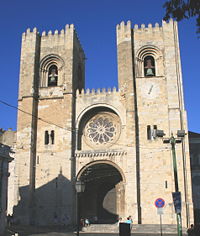
The Roman Sertorius led a large rebellion against the Dictator Sulla early in the Roman Period.
Among the majority of Latin speakers lived a large minority of Greek traders and slaves.
The city was connected by a broad road to Western Hispania's two other large cities, Bracara Augusta in the province of Tarraconensis (today's Portuguese Braga), and Emerita Augusta, the capital of Lusitania (now Mérida in Spain).
Olissipo, like most great cities in the Western Empire, was a centre for the dissemination of Christianity. Its first attested Bishop was St. Potamius (c. 356), and there were several martyrs killed by the pagans during the great persecutions; Maxima, Verissimus and Julia are the most significant names.
At the end of the Roman domain, Olissipo was one of the first Christian cities. It suffered invasions from the Sarmatian Alans and the Germanic Vandals, who controlled the region from 409 to 429. The Germanic Suebi, who established a kingdom in Gallaecia (modern Galicia and northern Portugal), with capital in Bracara Augusta ( Braga), from 409 to 585, also controlled the region of Lisbon for long periods of time.
In 585 the Suebi kingdom was included in the Germanic Visigothic kingdom of Toledo, that comprised all of the Iberian Peninsula. Lisbon was then called Ulishbona.
Moorish rule
In approximately 711 Lisbon was taken by the Moors (it was called al-ʾIšbūnah in Arabic الأشبونة), under whose rule the city flourished. The Moors, who were Muslims from North Africa and the Middle East, built many mosques and houses as well as a new city wall, currently named the Cerca Moura. The city kept a diverse population including Christians, Berbers, Arabs, Jews and Saqalibas.
Arabic was forced on the Christians as the official language. Mozarabic was the mother language spoken by the Christian population. Islam was the official religion practiced by the Arabs and Muladi ( muwallad), the Christians could keep their religion but under Dhimmi status and were required to pay the jizyah.
The Moorish influence is still present in Alfama, the old part of Lisbon that survived the 1755 Lisbon earthquake. Many placenames are derived from Arabic; the Alfama, the oldest existing district of Lisbon, for example, is derived from the Arabic "al-hamma".
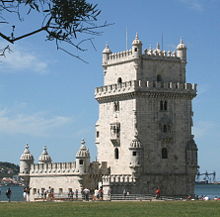
For a brief time during the Taifa period Lisbon was the centre town in the Regulo Eslavo of the Taifa of Badajoz and then as an independent Taifa ruled by Abd al-Aziz ibn Sabur and Abd al-Malik ibn Sabur sons of Sabur al-Jatib (Sabur the Slav), a Slav that had been at the service of al-Hakam II before ruling the Taifa of Badajoz.
In 1147, as part of the Reconquista, crusader knights led by Afonso I of Portugal, sieged and reconquered Lisbon. Lisbon was now back in Christian hands. Its inhabitants were around one hundred fifty-four thousand.
The reconquest of Portugal and re-establishment of Christianity is one of the most significant events in Lisbon's history; although it is known through the chronicle Expugnatione Lyxbonensi, attributed to Osburnus, that there was a bishop in the town that was killed by the crusaders and that the population was praying to the Virgin Mary when afflicted with plague, which indicates that the Mozarab population followed the Mozarabic rite. Arabic lost its place in everyday life. Any remaining Muslim population were gradually converted to Roman Catholicism, or expelled, and the mosques were turned into churches. (Though in Portuguese historiography this was often mentioned as "turning the mosques back into churches", in fact many of the structures concerned were built as mosques to begin with).
From the Middle Ages to the Portuguese Empire
It received its first Foral in 1179, and became the capital city of Portugal in 1255 due to its central location in the new Portuguese territory. The first Portuguese university was founded in Lisbon in 1290 by Dinis I of Portugal as Estudo Geral (General Study). The university was transferred several times to Coimbra, where it was installed definitively in the 16th century (today's University of Coimbra).
During the last centuries of the Middle Ages, the city expanded substantially and became an important trading post with both northern Europe and Mediterranean cities.
Most of the Portuguese expeditions of the age of discovery left from Lisbon during the 15th to 17th centuries, including Vasco da Gama's departure to India in 1497. The 16th century marks the golden age for Lisbon. The city became the European hub of commerce with Africa, India, the Far East and, later, Brazil, exploring riches like spices, slaves, sugar, textiles and other goods. This was the time of the exuberant Manueline style, which has left its mark in two 16th century Lisbon monuments, the Belém Tower and the Jerónimos Monastery, both of which were declared World Heritage Sites by UNESCO.
A description of Lisbon in the sixteenth century was written by Damião de Góis and published in 1554.
Portugal lost its independence to Spain in 1580 after a succession crisis, and the 1640 revolt that restored the Portuguese independence took place in Lisbon (see Philip III of Portugal). In the early 18th century, gold from Brazil allowed King John V to sponsor the building of several Baroque churches and theatres in the city.
1755 Lisbon earthquake
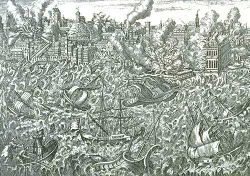
Prior to the 18th century, Lisbon had experienced several important earthquakes - eight in the 14th century, five in the 16th century (including the 1531 earthquake that destroyed 1,500 houses, and the 1597 earthquake when three streets vanished), and three in the 17th century. On 1 November 1755 the city was destroyed by another earthquake, which killed between 60,000 and 90,000 people and destroyed eighty-five percent of the city. With an estimated population of 275,000, Lisbon was, in 1755, one of the largest cities in Europe. Among several important structures of the city, the Royal Ribeira Palace and the Royal Hospital of All Saints were lost. The event shocked the whole of Europe. Voltaire wrote a long poem, "Poême sur le désastre de Lisbonne", shortly after the quake, and mentioned it in his 1759 novel Candide (indeed, many argue that this critique of optimism was inspired by that earthquake). Oliver Wendell Holmes, Sr. also mentions it in his 1857 poem, The Deacon's Masterpiece, or The Wonderful One-Hoss Shay. In the town of Cascais, some 30 km west of Lisbon, the waves wrecked several boats and when the water withdrew, large stretches of sea bottom were left uncovered. In coastal areas such as Peniche, situated about 80 km north of Lisbon, many people were killed by the tsunami. In Setúbal, 30 km south of Lisbon, the water reached the first floor of buildings. The destruction was also great in the Algarve, southern Portugal, where the tsunami dismantled some coastal fortresses and, in the lower levels, razed houses. In some places the waves crested at more than 30 m.
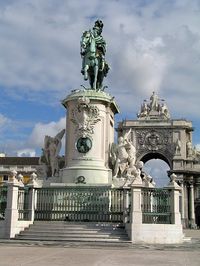
Almost all the coastal towns and villages of Algarve were heavily damaged, except Faro, which was protected by sandy banks. In Lagos, the waves reached the top of the city walls. For many Portuguese coastal regions, the destructive effects of the tsunami were more disastrous than those of the earthquake proper. In southwestern Spain, the tsunami caused damage to Cadiz and Huelva, and the waves penetrated the Guadalquivir River, reaching Seville. In Gibraltar, the sea rose suddenly by about two meters. In Ceuta the tsunami was strong, but in the Mediterranean Sea, it decreased rapidly. On the other hand, it caused great damage and casualties to the western coast of Morocco, from Tangier, where the waves reached the walled fortifications of the town, to Agadir, where the waters passed over the walls, killing many.
After the 1755 earthquake, the city was rebuilt largely according to the plans of Sebastião José de Carvalho e Melo, the Marquis of Pombal; hence the designation of the lower town as Baixa Pombalina ( Pombaline Downtown). Instead of rebuilding the medieval town, Pombal decided to demolish the remains of the earthquake and rebuild the downtown in accordance with modern urban rules.
19th and 20th centuries
In the first years of the 19th century, Portugal was invaded by the troops of Napoléon Bonaparte and Queen Maria I and Prince-Regent João (future John VI) temporarily fled to Brazil. Considerable property was pillaged by the invaders.
The city felt the full force of the Portuguese liberal upheavals, beginning its tradition of cafés and theatres. In 1879 the Avenida da Liberdade was opened, replacing a previous public garden.
Lisbon was the centre of the republican coup of October 5, 1910 which instated the Portuguese Republic. Previously, it was also the stage of the regicide of Carlos I of Portugal (1908).
The city refounded its university in 1911 after centuries of inactivity in Lisbon, incorporating reformed former colleges and other non-university higher education schools of the city (such as the Escola Politécnica - now Faculdade de Ciências). Today there are 3 public universities in the city ( University of Lisbon, Technical University of Lisbon and New University of Lisbon) and 2 public university institutes (IPL - Instituto Politécnico de Lisboa and ISCTE - Instituto Superior de Ciências do Trabalho e da Empresa) - see list of universities in Portugal.
During World War II Lisbon was one of the very few neutral, open European Atlantic ports, a major gateway for refugees to the U.S. and a spy nest.
In 1974, Lisbon was the central destination point of the Carnation Revolution maneuvers, the end of the Portuguese Corporative Regime ( Estado Novo).
In 1988, a fire near the historical centre of Chiado greatly disrupted normal life in the area for about 10 years.
In 1994, Lisbon was the European Capital of Culture.
Expo '98 was held in Lisbon. The timing was intended to commemorate the 500th anniversary of Vasco da Gama's sea voyage to India. It was considered by the Bureau of International Expositions the best world expo ever.
Contemporary events
The Lisbon Agenda was a European Union agreement on measures to revitalize the EU economy, signed in Lisbon in March 2000.
Every March the city hosts the world-famous Lisbon Half Marathon, one of the most attended events of its kind in the world.
It regularly hosts countless other international events including various NATO, European Union and other summits.
In 2004, Portugal organised the soccer Euro cup, Luz and Alvalade stadiums held some of the games.
Rock in Rio, known for being the biggest pop-rock festival in the world with an attendance that can reach 100 000 people, was held in Lisbon three times (2004, 2006 and 2008) and will continue in the city for some years, hosting concerts of many high profile singers and bands, such as Anastacia, Metallica, Shakira, Guns N' Roses, Roger Waters, Britney Spears, Red Hot Chili Peppers, Amy Winehouse and many more.
In January 2006 and 2007, Lisbon was the starting city of the Dakar Rally.
On the 7 July 2007, Lisbon held the ceremony of the "New 7 Wonders Of The World" election, in Luz stadium, with live transmition for millions of people all over the world.
On the 18 and 19 October 2007 Lisbon held the 2007 EU Summit, where agreement was reached regarding the Union governance model. The Treaty of Lisbon was signed on the 13 December 2007.
Climate
Lisbon is one of the mildest European capitals. Spring is cool to warm (between 6 °C and 28 °C) with sunshine and also some showers. Summer months are mostly sunny, dry, hot with a little breeze with temperatures between 16 °C to 37 °C. Autumn is mild and unsettled with temperatures between 8 °C and 23 °C and winters are typically rainy and cool with some sunny days (temperatures between 3 °C and 18 °C), usually staying at an average of 12 °C. Snowfall is a very rare occurrence — Lisbon briefly witnessed snow on January 29, 2006 and January 28, 2007 thanks to cold waves from the Arctic that affected Europe in those days. Before 2006, no snowfall had been registered for over forty years, just some sleety days. On average, there are 3300 sunny hours per year and 100 days with rain per year. Lisbon's climate is strongly influenced by the Gulf Stream.
| Weather averages for Lisbon | |||||||||||||
|---|---|---|---|---|---|---|---|---|---|---|---|---|---|
| Month | Jan | Feb | Mar | Apr | May | Jun | Jul | Aug | Sep | Oct | Nov | Dec | |
| Average high °C (°F) | 14 (57) | 16 (61) | 18 (64) | 19 (66) | 22 (72) | 26 (79) | 28 (82) | 29 (84) | 27 (81) | 22 (72) | 17 (63) | 15 (59) | |
| Average low °C (°F) | 8 (46) | 9 (48) | 11 (52) | 11 (52) | 14 (57) | 16 (61) | 18 (64) | 18 (64) | 17 (63) | 15 (59) | 12 (54) | 10 (50) | |
| Precipitation mm (inches) | 92 (3.62) | 61 (2.4) | 45 (1.77) | 54 (2.13) | 52 (2.05) | 9 (0.35) | 5 (0.2) | 6 (0.24) | 28 (1.1) | 96 (3.78) | 99 (3.9) | 109 (4.29) | |
| Source: Foreca 2008 | |||||||||||||
Demographics
The population of the city proper was 564,477 and the metropolitan area ( Lisbon Metropolitan Area) was 2,800,000 according to the Instituto Nacional de Estatística (National Institute of Statistics). The Lisbon Metropolitan Area coincides with two NUTS II units, Grande Lisboa (Greater Lisbon), in the northern bank of the Tagus, and Península de Setúbal (Setúbal Peninsula), to the south, which are the two subregions of Região Lisboa (Lisbon Region). The population density of the city itself is 6,658 inhabitants per square kilometer (17,244/sq mi).
Like most big cities, Lisbon is surrounded by many satellite cities. It is estimated that more than one million people enter Lisbon every day from the outskirts. Cascais and Estoril are among the most interesting neighbouring towns for night life. Beautiful palaces, landscapes and historical sites can be found in Sintra and Mafra. Other major municipalities around Lisbon include Amadora, Oeiras, Odivelas, Loures, Vila Franca de Xira and, in the south bank of the Tagus river estuary, Almada, Barreiro and Seixal.
Lisbon is ranked number 1 in the Portuguese most livable cities survey of living conditions published yearly by Expresso.
| Demographic evolution of Lisbon (1801 – 2004) | ||||||||
|---|---|---|---|---|---|---|---|---|
| 1801 | 1849 | 1900 | 1930 | 1960 | 1981 | 1991 | 2001 | 2004 |
| 203.999 | 174.668 | 350.919 | 591.939 | 801.155 | 807.937 | 663.394 | 564.657 | 529.485 |
Culture and sights
The heart of the city is the Baixa (Downtown) or city centre; this area of the city is being considered for UNESCO World Heritage Site status. The Baixa is organised in a grid system and a network of squares built after the 1755 Lisbon earthquake, which levelled a great portion of the medieval city. The Castle of São Jorge and the Lisbon Cathedral are located on one of the seven hills of Lisbon, to the east of the Baixa. The oldest district of the city is Alfama, close to the Tagus, which has made it relatively unscathed through the various earthquakes.
Other monuments include: the Castle of São Jorge, atop the tallest hill of the central city, Praça do Comércio (Commerce Square) with the beautiful façade of the Church of Nossa Senhora da Conceição Velha nearby, Rossio Square, Restauradores Square, Elevador de Santa Justa, an elevator (lift) in Gothic revival style, built around 1900 to connect the Baixa and Bairro Alto, the richly-decorated Church of São Roque, the Baroque and Neoclassical Estrela Basilica, the Manueline Jerónimos Monastery, Belém Tower, Padrão dos Descobrimentos (Monument of the Discoveries), Monastery of São Vicente de Fora and Carmo Convent.
The city of Lisbon is rich in architecture; Romanesque, Gothic, Manueline, Baroque, Traditional Portuguese, Modern and Post-Modern constructions can be found all over the city. The city is also crossed by great boulevards and monuments along these main thoroughfares, particularly in the upper districts; notable among these are the Avenida da Liberdade (Liberty Avenue), Avenida Fontes Pereira de Melo, Avenida Almirante Reis and Avenida da República (Republic Avenue). The most famous museums in Lisbon are the Museu Nacional de Arte Antiga (National Museum of Ancient Art), the Museu do Azulejo (Museum of Portuguese-style Tile Mosaics), the Museu Calouste Gulbenkian (Calouste Gulbenkian Museum, containing varied collections of ancient and modern art), the Lisbon Oceanarium (Oceanário de Lisboa, the largest in Europe), the Museu Nacional do Traje e da Moda (National Museum of Costume and Fashion), the Berardo Collection Museum (Modern Art) at the Belém Cultural Centre, the Museu Nacional dos Coches (National Coach Museum, containing the largest collection of royal coaches in the world) and the Museu da Farmácia (Pharmacy Museum).
Lisbon's opera house, the Teatro Nacional de São Carlos, hosts a relatively active cultural agenda, mainly in autumn and winter. Other important theatres and musical houses are the Centro Cultural de Belém, the Teatro Nacional D. Maria II and the Gulbenkian Foundation.
The monument to Christ the King (Cristo Rei) stands on the left side of the river, in Almada. With open arms, overlooking the whole city, it resembles the Corcovado monument in Rio de Janeiro, and was built after World War II, as thanks for Portugal's being spared the horrors and destruction of the war.
Every June there are 5 days of popular street celebrations in memory of a saint born in Lisbon – Anthony of Lisbon (or Santo António). Saint Anthony, also known as Saint Anthony of Padua, was a wealthy Portuguese bohemian who was canonised and made Doctor of the Church after a life preaching to the poor, simpler people. Although Lisbon’s patron saint is Saint Vincent, whose remains are in the Lisbon Cathedral, there are no festivities associated with him.
Parque Eduardo VII is the second largest park of the city after Parque Florestal de Monsanto, prolonging the main avenue ( Avenida da Liberdade). Originally named Parque da Liberdade, was after renamed Park Edward VII of England who visited Lisbon in 1903, it includes a large variety of plants in a winter garden (Estufa Fria).
Lisbon is home every year to the Lisbon Gay & Lesbian Film Festival.
Economy
The Lisbon region is the wealthiest region in Portugal and it is well above the European Union's GDP per capita average - it produces 45% of the Portuguese GDP. Lisbon's economy is based primarily on the tertiary sector. Most of the headquarters of multinationals operating in Portugal are concentrated in the Grande Lisboa subregion, specially in the Oeiras municipality. Lisbon Metropolitan Area is heavily industrialized, especially the south bank of the Tagus river (Rio Tejo).
The country's chief seaport and featuring one of the largest and most sophisticated regional markets within the Iberian Peninsula, Lisbon and its heavily populated surroundings, are also developing as an important financial centre and a dynamic technological hub.
Lisbon has the largest and most developed mass media sector of Portugal, and is home to several related companies ranging from leading television networks and radio stations to major newspapers.
The Euronext Lisbon stock exchange, part of the pan-European Euronext system together with the stock exchanges of Amsterdam, Brussels and Paris, is tied with the New York Stock Exchange since 2007, forming the multinational NYSE Euronext group of stock exchanges.
Transport
Lisbon's public transport network is extremely far-reaching and reliable and has its Metro as its main artery, connecting the city centre with the upper and eastern districts, and now reaching the suburbs. Ambitious expansion projects will increase the network by almost one third, connecting the airport, and the northern and western districts. Bus, funicular and tram services have been supplied by the Companhia de Carris de Ferro de Lisboa ( Carris), for over a century.
A traditional form of public transport in Lisbon is the tram. Originally introduced in the 19th century, the trams were originally imported from the U.S. and called americanos. The original trams can still be seen in the Museu da Carris (the Public Transport Museum) ( Carris). Other than on the modern Line 15, the Lisbon tramway system still employs small (four wheel) vehicles of a design dating from the early part of the twentieth century. These distinctive yellow trams are one of the tourist icons of modern Lisbon, and their size is well suited to the steep hills and narrow streets of the central city.
There are other commuter bus services from the city: Vimeca ( ), Rodoviaria de Lisboa ( ), Transportes Sul do Tejo ( ), Boa Viagem ( ), Barraqueiro ( ) are the main ones, operating from different terminals in the city.
There are four commuter train lines departing from Lisbon: the Cascais, Sintra and Azambuja lines as well as a fourth line to Setúbal crossing the Tagus river over the 25 de Abril Bridge. The major railway stations are Santa Apolónia, Rossio, Gare do Oriente and Cais do Sodré.
The city does not offer a light rail service (tram line 15, although running with new and faster trams does not fall onto this category), but there are plans to build some lines with this service around the city (but not into the city itself).
The city is connected to the far side of the Tagus by two important bridges:
- The 25 de Abril Bridge, inaugurated (as Ponte Salazar) on August 6 1966, and later renamed after the date of the Carnation Revolution, was the longest suspension bridge in Europe and although made by the same engineers as the Golden Gate Bridge in San Francisco, it is not, as thought by some, a replica (the Golden Gate Bridge does not have X braces).
- The Vasco da Gama Bridge, inaugurated on May 1998 is, at 17.2 km (10.7 mi), the longest bridge in Europe.
Another way of crossing the river is by taking the ferry. The main company is Transtejo ( ), which operates from different points in the city to Cacilhas, Seixal, Montijo, Porto Brandão and Trafaria and the other company is Soflusa ( ), operating one only line to Barreiro.
Lisbon is connected to its suburbs and the rest of Portugal by an extensive motorway network. There are three circular motorways around the city; the 2ª Circular, the CRIL and the CREL.
The Portela Airport is located within the city limits. TAP and Portugalia have their hubs here and the flights available are mostly to Europe, Africa and America.
Education in Lisbon
The city has several private and public secondary schools, primary schools as well as kindergartens. In Greater Lisbon area there are also international schools such as Saint Julian's School, the Carlucci American International School of Lisbon, St Dominic's International School, Deutsche Schule Lissabon, and Lycée Francais Charles Lepierre.
There are 3 major public universities in Lisbon: the University of Lisbon (Lisbon's oldest higher education institution), the Technical University of Lisbon and the New University of Lisbon, providing degrees in all academic disciplines. There is also two state-run university-institutes: the Polytechnical Institute of Lisbon and the ISCTE.
Major private institutions of higher education include the Portuguese Catholic University, as well as the Moderna University, the Lusíada University, the Universidade Lusófona, the Instituto Superior de Psicologia Aplicada and the Universidade Autónoma de Lisboa.
Sports
The Lisbon sports clubs Sport Lisboa e Benfica (commonly "Benfica") and Sporting Clube de Portugal (commonly "Sporting"), have many sports teams in the highest Portuguese divisions and European competitions. Belenenses, another important club with a great tradition in Portuguese sport, is also from the Portuguese capital.
Football is the most popular sport in Lisbon. Major football clubs include SL Benfica, with its home 65,000 seat stadium the UEFA 5-Star Stadium Estádio da Luz (named after the area in which the stadium is situated (Luz) and not, as is popularly believed, 'Stadium of Light'). Benfica has won the UEFA Champions League twice and has appeared in the final seven times. Sporting Clube de Portugal is the other major football team from the city, also having a UEFA 5-Star stadium, 52,000 seat Estádio José de Alvalade stadium. It has won the UEFA Cup Winners Cup once and was the UEFA Cup finalist in the 2004-05 season. Former players from this team include Luís Figo and Cristiano Ronaldo. Belenenses is the third most important football team in the city, having Estádio do Restelo as its home stadium in the Belém neighbourhood of Lisbon. Belenenses holds the distinction of being the first club, other than perennial winners Sporting, Benfica and Porto, to win the Portuguese League, taking the trophy in the 1945-46 season.
Other sports, such as indoor football, handball, basketball and roller hockey are also popular.
There are many other sport facilities in Lisbon, ranging from athletics to sailing to golf to mountain-biking.
Tourist attractions
Belém
Along the Rio Tejo (Tagus River), is the historic neighbourhood of Belém. Its prime attraction is the grand Mosteiro dos Jeronimos. Construction started in 1501, and took 70 years to complete. During its construction, the monastery cost an equivalent of 70 kg (154 lb) of gold each year. Most of the construction costs were financed through the spice trade. It is a prime example of what is called Manueline architecture, with inspiration brought back from the explorations, as well as being influenced by the Gothic and Renaissance periods. Nearby is the Belem Tower.
Bairro Alto
Bairro Alto (literally upper quarter in Portuguese) is an area of central Lisbon. It functions as a residential, shopping and entertainment district. Today, the Bairro Alto is the heart of Lisbon's youth and of the Portuguese capital's nightlife. Lisbon's Punk, Gay, Metal, Goth, Hip Hop and Reggae scenes, all have the Bairro as their home, due to the number of clubs and bars dedicated to each of them. The fado, Portugal's national song, still survives in the new Lisbon's nightlife. The crowd is a mix of local and tourist, straight and gay, and almost anything else imagined.
Gare do Oriente
Gare do Oriente (Orient Station) is one of the main transportation hubs of Lisbon, for trains, metro, buses and taxis. Its glass and steel columns are reminiscent of palms, making the whole structure fascinating to look at (especially in sunlight or when illuminated at night). It was designed by the architect Santiago Calatrava from Valencia (Spain). Cross through the shopping mall just across the street and you're in Parque das Nações (Park of the Nations), site of the 1998 World Expo.
Lisbon Trams and Funiculars
Transportation in Lisbon is more charming than in most cities. Much is owed to its geography; much of Lisbon has been built on its seven hills. No visit to Lisbon is complete without riding the 1930s trams. The greatest attractions, though, are the funiculars, of which there are three. These are Elevador da Glória, Elevador da Bica, and Elevador da Lavra. Perhaps the most picturesque is the Elevador da Bica, which passes through a charming residential neighbourhood just below Bairro Alto..
Parishes
There are 53 freguesias ( civil parishes) in Lisbon:
|
|
|
Furthermore, and more commonly referred to by its inhabitants, Lisbon is divided into historical "bairros" with no clearly defined boundaries, such as Amoreiras, Bairro Alto, Bica, Alfama, Mouraria, Avenidas Novas, Intendente, Chelas and Lapa.
Prominent people born in Lisbon
- Saint Anthony of Lisbon (1195-1231)
- Pope John XXI, born Pedro Julião (1215-1277)
- Francisco de Almeida, (1450-1510) Portuguese admiral, the first Viceroy of Portuguese India.
- Antonio Vieira (1608-1697), Jesuit
- Catherine of Braganza (1638-1705), queen consort of King Charles II of England
- Richard William Church (1815-1890)
- Fernando Pessoa (1888-1935), poet / writer
- Amália Rodrigues (1920-1999), fado / singer
- Mário Cesariny (1923-2006), poet
- Alexandre O'Neill (1924-1986), poet / writer
- Mário Soares (born 1924), politician, former President and Prime-Minister
- Paula Rego (born 1935), painter, illustrator and printmaker
- Jorge Sampaio (born 1939), politician, former Mayor of Lisbon and President
- António Guterres (born 1949), United Nations High Commissioner for Refugees, former Prime-Minister
- José Manuel Durão Barroso (born 1956), President of the European Commission, former Prime-Minister
Sister cities
The following places are sister cities to Lisbon:
 Jersey City, United States
Jersey City, United States Paris, France
Paris, France Budapest, Hungary (1992)
Budapest, Hungary (1992) Zagreb, Croatia (1977)
Zagreb, Croatia (1977) Madrid, Spain (1979)
Madrid, Spain (1979) Nicosia, Cyprus
Nicosia, Cyprus Buenos Aires, Argentina
Buenos Aires, Argentina
 Macau, People's Republic of China
Macau, People's Republic of China Athens, Greece
Athens, Greece Montreal , Canada
Montreal , Canada
Within the context of development cooperation, Lisbon is also linked to:
 Belo Horizonte, Brazil
Belo Horizonte, Brazil Bissau, Guinea-Bissau
Bissau, Guinea-Bissau Brasilia, Brazil
Brasilia, Brazil Cacheu, Guinea-Bissau
Cacheu, Guinea-Bissau Luanda, Angola
Luanda, Angola Malacca, Malaysia (1984)
Malacca, Malaysia (1984) Maputo, Mozambique
Maputo, Mozambique Praia, Cape Verde
Praia, Cape Verde Rabat, Morocco'
Rabat, Morocco' Rio de Janeiro, Brazil (1980)
Rio de Janeiro, Brazil (1980) São Paulo, Brazil
São Paulo, Brazil São Tomé, São Tomé and Príncipe
São Tomé, São Tomé and Príncipe
